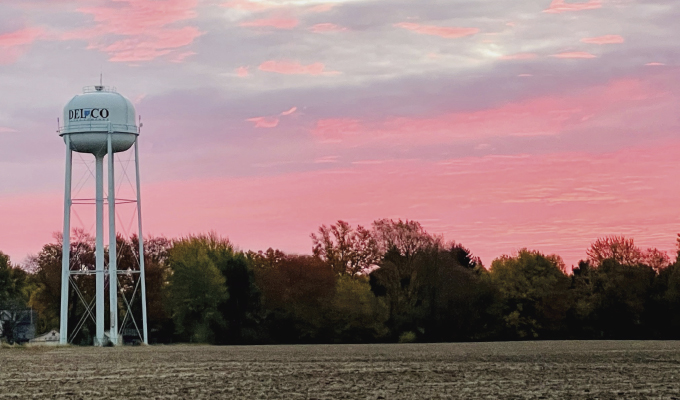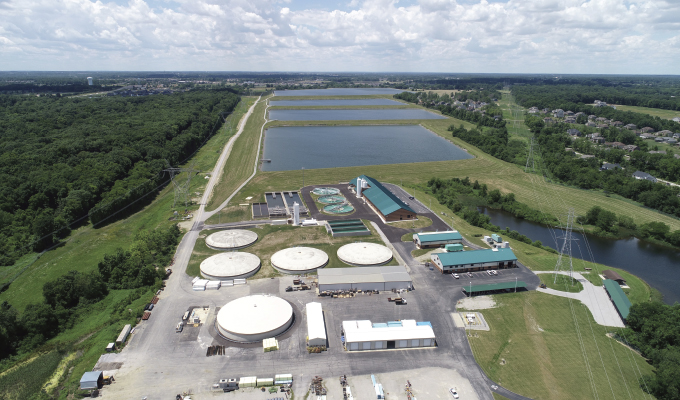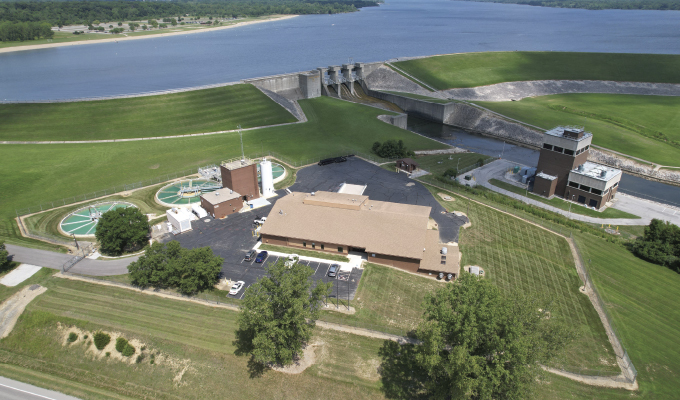Del-Co Water Company was formed in 1969 and has grown from a small rural utility to one of Ohio’s largest public water systems, serving over 55,000 customers across eight counties. The company sources water from Alum Creek, Olentangy River, Scioto River, and an aquifer in northern Morrow and southern Knox Counties. Del-Co has a series of six up-ground reservoirs to accumulate over 2.6 billion gallons of raw water if needed during dry periods.
The company has four treatment plants, two overseen by long-term Water Plant Manager Damon Dye (thirty-seven years with Del-Co). Three plants have on-site water quality laboratories managed by another long-time employee, Shannen Green (twenty-eight years with Del-Co).
Growth brings new challenges to water management and requires efficient data management to keep operations running smoothly and ensure regulatory compliance. The company’s journey to streamline operations and improve efficiency led them to adopt the Hach WIMS (Water Information Management Solution) Platform, a decision that has saved time and improved operations.
Del-Co Water relied on traditional paper-based methods for recording and managing its water quality data for years. Both Green and Dye recognized the limitations of this in the age of IoT and the digital utility.
“Before WIMS, we wrote everything on paper and kept it forever; you can imagine boxes and boxes of papers sitting in storage,” Green recalls. “The process of managing this data was time-consuming and prone to errors. Sharing physical copies with stakeholders was arduous and cumbersome, so it only happened when absolutely necessary.”
The paperwork was a burden for management and plant operators, who had to go through reams of paper for bench sheets and then file and store them. The company’s growth had outpaced manual entry in multiple places across multiple departments for multiple purposes.
CHANGE OFTEN COMES WITH CHALLENGES
In their search for a solution, Green and Dye discovered WIMS, a comprehensive software platform designed to help water and wastewater utilities collect, manage, and analyze operational and compliance data effectively.
“Some plant operators were against change—they fought it for a little while,” says Dye. Green faced similar challenges with her lab personnel, so they worked closely with their teams, providing training and support to ease the transition.
The new system’s benefits quickly became apparent when Green and Dye created bench sheets for the lab and treatment plants within WIMS. These customized data entry forms make it easy for lab technicians and plant operators to input data directly into the system once.
With the data in the system, they can use the QA/QC tools to identify and correct errors quickly. Having all the information in one place also creates an audit trail and helps with problem-solving by showing historical data, along with notes from operators, next to data that is outside of set parameters.
As Dye points out, “Operators like being able to quickly pull up historical data in the computer rather than going upstairs to look in a filing cabinet and searching through papers to try and figure out what we did about a turbidity issue in the past. Because it is now easy to do, it’s easier to stay on top of things by using all the data at our fingertips to make quicker, better decisions.”

AUTOMATION SAVES TIME AND MONEY ON CHEMICAL DOSING
The new software automatically calculates chemical dosages using built-in formulas, significantly improving efficiency compared to the previous method of writing on bench sheets and manually calculating chemical dosages, flow rates, and velocities. The automation saves time and ensures precise amounts of chemicals like lime, ferric chloride, orthophosphate, fluoride, and sodium hypochlorite are used for optimal water quality and minimal chemical waste. If a chemical feed change does not yield the desired result within an hour, the program sends an alert, allowing operators to decide on the next steps.
High-flow seasons, like springtime, can lead to increased water turbidity due to factors such as snowmelt and heavy rainfall. This can introduce more sediments and organic matter into the water, making it cloudier. Having software that allows quick reference to historical data is incredibly valuable. It enables operators to adjust chemical dosages more efficiently and accurately, ensuring the water remains safe and clean for consumption. By analyzing past data, Del-Co can predict turbidity trends and prepare accordingly, optimizing the treatment process and reducing the risk of water quality issues.
Dye adds, “In the first year of using the software, we went back and looked at previous turbidity levels and water temperature, and from that, we knew what dosage was required. Before this, we had to go upstairs and pull all the paperwork, taking at least a day. Now it takes five minutes, and we change the dosage right away because we have all the proven data to meet requirements.”
THE OHIO EPA: AN UNEXPECTED ALLY
State regulatory bodies play a vital role in ensuring compliance and safeguarding public interests, though their policies can sometimes present challenges. However, the Ohio Environmental Protection Agency proved to be a valuable partner, supporting Del-Co’s efforts throughout its digital transformation journey. “They were just transitioning into electronic submissions at about the same time that we were leaning that way,” Dye explains, “So collaboratively, we were able to make it work.”
This progressive stance by the Ohio EPA highlights a broader trend in the industry—a recognition that embracing technology is beneficial and necessary for effective water management and public safety.
The program’s ability to automatically generate required reports has made compliance with Ohio Environmental Protection Agency (Ohio EPA) regulations more straightforward and less time-consuming. Dye explains, “As the operators enter data, it creates the monthly report for me, and I can just send it directly to the EPA now. It saves me hours and hours a month of working on that.”
Green uses Lab Cal to schedule weekly and monthly bacterial samples, such as total coliform and chlorine. Lab Cal lists the required samples for each week. A colleague logs the results into LabCal, and Green quickly reviews the data for errors. This data is then exported as an XML file, integrated into the EPA form, and submitted online.
Green notes, “It has saved a lot of time and cut back on data entry errors. It used to take me around four hours to create my monthly reports, and now it takes about fifteen minutes. It’s that simple.”

CONTINUOUS IMPROVEMENT: THE NEW NORMAL
While the implementation of WIMS has been largely successful, Del-Co Water continues to look for ways to maximize its potential. Green expresses interest in expanding their use of the system: “I’d like to do more with it. We don’t use graphs or graphical dashboards, and I think that would be amazing, especially with our turbidity levels.”
The company is also working on standardizing the program usage across all its facilities. Two plants still use paper bench sheets before logging data into WIMS. The team recognizes this as an area for improvement and is working towards full digital integration across all plants.
Del-Co is adding WIMS Rio, a cloud-based software program on the Platform that allows personnel to capture field data on-site with a connected mobile device that feeds information directly into the platform.
THE POWER OF COMMUNITY LEARNING
One unexpected benefit of deploying the new software has been the opportunity to learn from peers in the industry. Green and Dye attend user conferences, where they discover new ways to leverage the software.
“This is by far the best conference I attend every year,” Green says, her enthusiasm palpable. “It’s more valuable than the big industry shows. We know there is so much more to learn, and finding out what our peers are doing with the program is amazing.”
These conferences have become a melting pot of ideas, breaking down the silos that often exist between water utilities. The exchange of ideas and best practices has become a valuable resource for continuous improvement at the utility.
THE ROAD AHEAD
As Del-Co Water looks to the future, the software remains a cornerstone of its operations. The company is excited about upcoming enhancements, such as voice dictation features in the mobile app, which promise to make data entry even more efficient.
But beyond the technical aspects, the program has instilled a new mindset of continuous improvement, data-driven decision-making, and embracing change. It’s a mindset that will serve Del-Co well as they face future challenges, from climate change to evolving regulations. The right technology, combined with visionary leadership and a willingness to adapt, can transform a utility from the inside out.
In the end, it’s not just about managing data or saving time and costs. It’s about ensuring every drop of water delivered to homes and businesses is safe, clean, and carefully accounted for. It’s about building trust with the community and safeguarding a vital resource for future generations.
Alexandra Young is an account executive at Aquatic Informatics specializing in water and wastewater data management. Once a dedicated teacher, Young brings her analytical skills and passion for problem-solving to help utilities optimize their operations through effective data solutions. Aquatic Informatics provide ongoing support and training for newly released features through regular software updates, ensuring that utilities get the most out of their data with the constant evolution of technology. For more information, visit www.aquaticinformatics.com.


